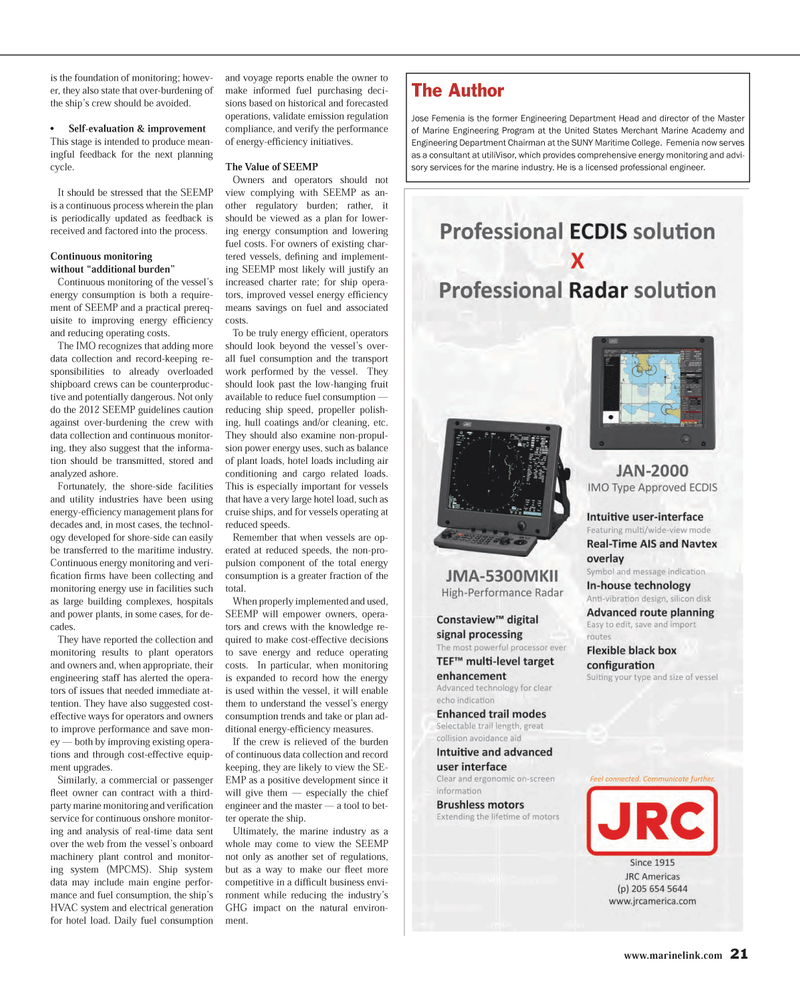
Page 21: of Maritime Reporter Magazine (May 2014)
Marine Electronics Edition
Read this page in Pdf, Flash or Html5 edition of May 2014 Maritime Reporter Magazine
www.marinelink.com 21 is the foundation of monitoring; howev- er, they also state that over-burdening of the ship’s crew should be avoided. • Self-evaluation & improvement
This stage is intended to produce mean- ingful feedback for the next planning cycle.
It should be stressed that the SEEMP is a continuous process wherein the plan is periodically updated as feedback is received and factored into the process.
Continuous monitoring without “additional burden”
Continuous monitoring of the vessel’s energy consumption is both a require- ment of SEEMP and a practical prereq- uisite to improving energy effi ciency and reducing operating costs.
The IMO recognizes that adding more data collection and record-keeping re- sponsibilities to already overloaded shipboard crews can be counterproduc- tive and potentially dangerous. Not only do the 2012 SEEMP guidelines caution against over-burdening the crew with data collection and continuous monitor- ing, they also suggest that the informa- tion should be transmitted, stored and analyzed ashore.
Fortunately, the shore-side facilities and utility industries have been using energy-effi ciency management plans for decades and, in most cases, the technol- ogy developed for shore-side can easily be transferred to the maritime industry.
Continuous energy monitoring and veri- fi cation fi rms have been collecting and monitoring energy use in facilities such as large building complexes, hospitals and power plants, in some cases, for de- cades.
They have reported the collection and monitoring results to plant operators and owners and, when appropriate, their engineering staff has alerted the opera- tors of issues that needed immediate at- tention. They have also suggested cost- effective ways for operators and owners to improve performance and save mon- ey — both by improving existing opera- tions and through cost-effective equip- ment upgrades.
Similarly, a commercial or passenger fl eet owner can contract with a third- party marine monitoring and verifi cation service for continuous onshore monitor- ing and analysis of real-time data sent over the web from the vessel’s onboard machinery plant control and monitor- ing system (MPCMS). Ship system data may include main engine perfor- mance and fuel consumption, the ship’s
HVAC system and electrical generation for hotel load. Daily fuel consumption and voyage reports enable the owner to make informed fuel purchasing deci- sions based on historical and forecasted operations, validate emission regulation compliance, and verify the performance of energy-effi ciency initiatives.
The Value of SEEMP
Owners and operators should not view complying with SEEMP as an- other regulatory burden; rather, it should be viewed as a plan for lower- ing energy consumption and lowering fuel costs. For owners of existing char- tered vessels, defi ning and implement- ing SEEMP most likely will justify an increased charter rate; for ship opera- tors, improved vessel energy effi ciency means savings on fuel and associated costs.
To be truly energy effi cient, operators should look beyond the vessel’s over- all fuel consumption and the transport work performed by the vessel. They should look past the low-hanging fruit available to reduce fuel consumption — reducing ship speed, propeller polish- ing, hull coatings and/or cleaning, etc.
They should also examine non-propul- sion power energy uses, such as balance of plant loads, hotel loads including air conditioning and cargo related loads.
This is especially important for vessels that have a very large hotel load, such as cruise ships, and for vessels operating at reduced speeds.
Remember that when vessels are op- erated at reduced speeds, the non-pro- pulsion component of the total energy consumption is a greater fraction of the total.
When properly implemented and used,
SEEMP will empower owners, opera- tors and crews with the knowledge re- quired to make cost-effective decisions to save energy and reduce operating costs. In particular, when monitoring is expanded to record how the energy is used within the vessel, it will enable them to understand the vessel’s energy consumption trends and take or plan ad- ditional energy-effi ciency measures.
If the crew is relieved of the burden of continuous data collection and record keeping, they are likely to view the SE-
EMP as a positive development since it will give them — especially the chief engineer and the master — a tool to bet- ter operate the ship.
Ultimately, the marine industry as a whole may come to view the SEEMP not only as another set of regulations, but as a way to make our fl eet more competitive in a diffi cult business envi- ronment while reducing the industry’s
GHG impact on the natural environ- ment.
The Author
Jose Femenia is the former Engineering Department Head and director of the Master of Marine Engineering Program at the United States Merchant Marine Academy and
Engineering Department Chairman at the SUNY Maritime College. Femenia now serves as a consultant at utiliVisor, which provides comprehensive energy monitoring and advi- sory services for the marine industry. He is a licensed professional engineer.
MR #5 (18-25).indd 21 4/30/2014 4:17:49 PM

 20
20

 22
22
